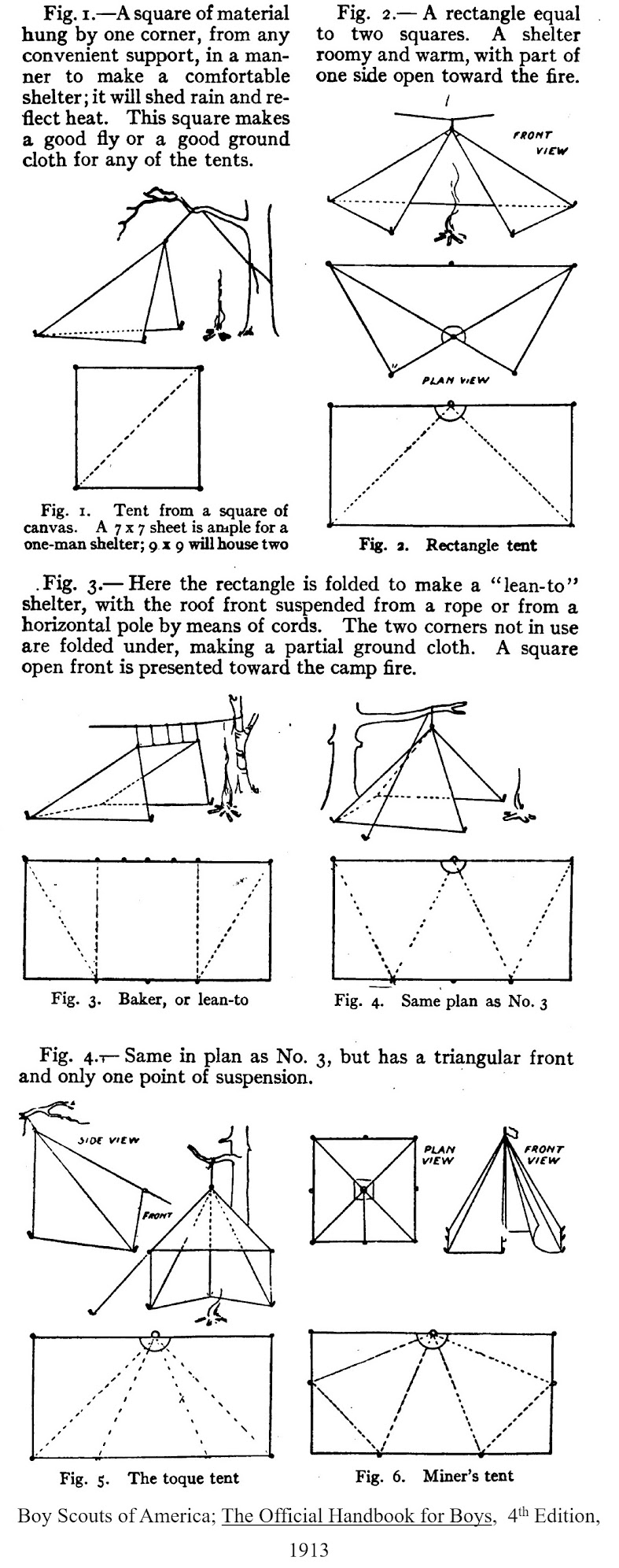Your
plane or car crashed, you’re lost or stranded, or there was a disaster (pick
one); it is rainy, snowy, windy, cold (pick one, maybe even two), and you need
shelter NOW! All you have is a bit of canvas, or a piece of plastic (again pick one).
So, how are going to use that bit of canvas or plastic to protect you
from the elements? That depends on whether
it is square or rectangular, how big it is, and on the weather conditions,
terrain, and how creative and good at improvising you are.
Just a small bit...
Whether square or rectangular, if you have
just a small, twin-blanket sized piece, only 65 inches by 90 inches (1.65 by 2.29
meters), tall and wide, then it will be too small to be made into a tent or
lean-to, although you can still use it for shelter.
You could use it to make a wind screen or put
it on the ground to protect you from heat loss due to conduction to the cold,
wet ground. Some different examples of
shelters are illustrated to the left.
Or, you could simply wear it like a matchcoat
(for more on matchcoats see “How to Wear a Blanket as a Matchcoat ©”, HERE). Remember, that proper
clothing is your first shelter from the environment, and if you don’t have
windproof or waterproof outer layers, you must improvise them.
If it’s a little bit bigger...
A larger piece of canvas, or plastic, either
square or rectangular, can be used in a lot of ways to make a shelter. The only limiting factor is how good your improvising
skills are, and what else you have to work with, such as line, poles, or other
materials.
A square 7 feet by 7 feet (2 meters by 2 meters) would be good for a one person shelter and a 10 feet by 10 feet (3 meter by 3 meters) square of canvas or plastic would be good for two people, and even five people in a pinch. Some different designs are shown below.
And
you could even use that square of plastic or canvas to create a bender
tent. For more on bender tents, read “A
Bender©”, HERE.
To tie lines to your tarp, make an improvised grommet with a small, smooth, round rock or pinecone, tied into a folded over corner of the tarp with a slip knot, also known as a tensionless hitch. This knot is like an overhand knot, with a loop pulled through. You can also tie an improvised grommet into the center of your tarp, if needed.
You
quickly decide what shelter to build with what you have at hand, and before
long it is built, you have gathered enough wood to last the night, and you are
sitting down beside a crackling fire, waiting for rescue.
Don’t forget to come back next week and read “Baking Bannock Bread for
Thanksgiving”, where we will talk about cooking, and eating, bannock bread.
I
hope that you continue to enjoy The Woodsman’s Journal Online and look for me
on YouTube at BandanaMan Productions for other related videos, HERE. Don’t forget to follow me on both The
Woodsman’s Journal Online, HERE,
and subscribe to BandanaMan Productions on YouTube. If you have questions, as always, feel free
to leave a comment on either site. I
announce new articles on Facebook at Eric Reynolds, on Instagram at
bandanamanaproductions, and on VK at Eric Reynolds, so watch for me.
That
is all for now, and as always, until next time, Happy Trails!
Sources
Boy Scouts of America;
The Official Handbook for Boys, 4th
Edition, [Double Day, Page & Company, Garden City, NY, 1913], page 164-170,
https://books.google.com/books?id=bFELAQAAIAAJ&newbks=1&newbks_redir=0&printsec=frontcover&pg=PR13&dq=tent+making+made+easy+by+h.j.holden+pdf&hl=en#v=onepage&q=tent%20making%20made%20easy%20by%20h.j.holden%20pdf&f=false, accessed November
11, 2023
Curtis,
Sam; “Ever Ready Tarp-Tent”, Boys' Life, October 1977, Vol. 67, No. 10, page
79, https://books.google.com/books?id=7FrDPWCDoKoC&printsec=frontcover&dq=Boys%27+Life+Oct+1977&hl=en&sa=X&ved=2ahUKEwiO3Orn3LyCAxWNElkFHUO7AP4Q6AF6BAgLEAI#v=onepage&q=Boys'%20Life%20Oct%201977&f=false, accessed November 11, 2023
Hall,
George, Rev.; The Gypsy’s Parson, [Sampson, Low & Marston, Ltd.,
London, 1915], https://books.google.com/books?id=7Rs1AQAAIAAJ&printsec=frontcover&dq=%22The+Gypsy%27s+Parson%22&hl=en&newbks=1&newbks_redir=0&sa=X&ved=2ahUKEwivz5OI2peCAxVlJH0KHXnbC88Q6AF6BAgMEAI#v=onepage&q=%22The%20Gypsy's%20Parson%22&f=false, accessed October 28, 2023
Howe, Steve; “Under the
Big Top”, Backpacker, June 1994, Vol. 23, No. 133, page 59-62, https://books.google.com/books?id=BuEDAAAAMBAJ&pg=RA1-PA84&dq=Backpacker+June+1994&hl=en&sa=X&ved=2ahUKEwi6tKWy9ryCAxWnFlkFHZ9MAbIQ6AF6BAgEEAI#v=onepage&q=Backpacker%20June%201994&f=false,
accessed November 11, 2023
Jacobson, Cliff; “Rig a
Rain Tarp in Three Minutes”, Boys' Life, May 1991, Vol. 81, No. 5, page
6, https://books.google.com/books?id=gvgDAAAAMBAJ&pg=PA3&dq=Boys%27+Life+May+1991&hl=en&sa=X&ved=2ahUKEwjSmeGS4LyCAxWjVDUKHaCnAV84ChDoAXoECAwQAg#v=onepage&q=Boys'%20Life%20May%201991&f=false,
accessed November 11, 2023
Newman,
Bob; “The World According to Tarp”, Field & Stream, October 1997, Vol.
102, No. 6, pages 98 to 99, https://books.google.com/books?id=x6HMEU2LfTMC&pg=PA84&dq=Field+%26+Stream+Oct+1997&hl=en&sa=X&ved=2ahUKEwiag8Txgr2CAxWIFmIAHbz3B584ChDoAXoECAYQAg#v=onepage&q=Field%20%26%20Stream%20Oct%201997&f=false,
accessed November 11, 2023
Ritter, Doug, “Tarp
Shelters – An Introduction”, Equipped to Survive, http://www.equipped.org/tarp-shelters.pdf,
accessed November 11, 2023
Wikimedia; “Tensionless
hitch”, August 13, 2013, by Hadron137, https://en.wikipedia.org/wiki/Slip_knot,
accessed November 11, 2023










,_plate_IX,_opposite_21_-_BL%20trimmed.jpg)
No comments:
Post a Comment